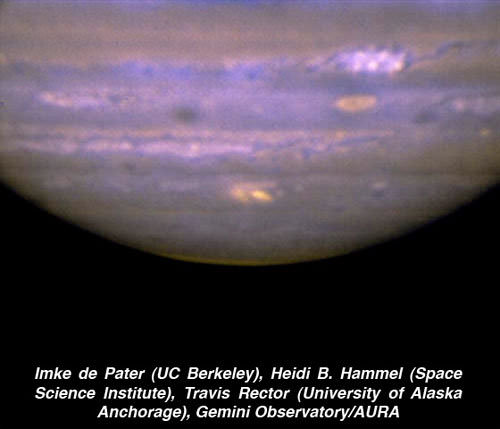[/caption]
After getting whacked unexpectedly by a small comet or asteroid, Jupiter is sporting a “bruise,” which has been big news this week. In visible wavelengths, the impact site appears as a black spot. But in a new image taken in near infrared by the Gemini North telescope on Mauna Kea, Hawai’i, the spot shows up in spectacular glowing yellow.
“We utilized the powerful mid-infrared capabilities of the Gemini telescope to record the impact’s effect on Jupiter’s upper atmosphere,” said Imke de Pater from the University of California, Berkeley. “At these wavelengths we receive thermal radiation (heat) from the planet’s upper atmosphere. The impact site is clearly much warmer than its surroundings, as shown by our image taken at an infrared wavelength of 18 microns.”
As Universe Today reported earlier, this new spot on Jupiter was first seen by Australian amateur astronomer Anthony Wesley on July 19th. This set off a flurry of activity as the large ground based observatories have imaged Jupiter in attempt to learn more about the impact and the object that struck Jupiter. Astronomers now say the object was likely a small comet or asteroid, just a few hundreds of meters in diameter. Such small bodies are nearly impossible to detect near or beyond Jupiter unless they reveal cometary activity, or, as in this case, make their presence known by impacting a giant planet.
In infrared, the impact site shows up in remarkable detail. “The structure of the impact site is eerily reminiscent of the larger Shoemaker-Levy 9 sites 15 years ago,” remarked Heidi Hammel (Space Science Institute), who was part of the team that supported the effort at Gemini. In 1994, Hammel led the Hubble Space Telescope team that imaged Jupiter when it was pummeled by a shattered comet. “The morphology is suggestive of an arc-like structure in the feature’s debris field,” Hammel noted.
The Gemini images were obtained with the MICHELLE spectrograph/imager, yielding a series of images at 7 different mid-infrared wavelengths. Two of the images (8.7 and 9.7 microns) were combined into a color composite image by Travis Rector at the University of Alaska, Anchorage to create the final false-color image. By using the full set of Gemini images taken over a range of wavelengths from 8 to 18 microns, the team will be able to disentangle the effects of temperature, ammonia abundance, and upper atmospheric aerosol content. Comparing these Gemini observations with past and future images will permit the team to study the evolution of features as Jupiter’s strong winds disperse them.
“The Gemini support staff made a heroic effort to get these data,” said de Pater. “We were on the telescope observing within 24 hours of contacting the observatory.” Because of the transient nature of this event, the telescope was scheduled as a “Target of Opportunity” and required staff to react quickly to the request.”
Source: Gemini Observatory


I wonder how much more energy the same impacting body would have on Jup than on Earth?
How much acceleration from the planet does a body in solar orbit get, as it gets near?
1. Manu Says:
July 23rd, 2009 at 9:33 am
“I wonder how much more energy the same impacting body would have on Jup than on Earth?”
You’d have to think: significantly more for a given approach trajectory…
“How much acceleration from the planet does a body in solar orbit get, as it gets near?”
It’d all depend on the specifics of the geometry of the encounter…
congrats to anthony wesley.